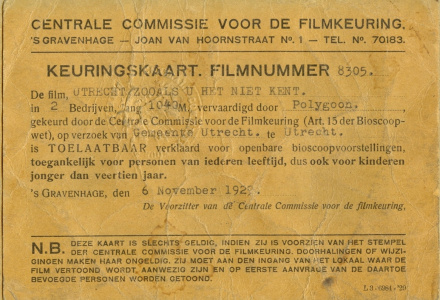Centrale Commissie voor de Filmkeuring
On 1 March 1928, the Bioscoopwet (‘Cinema law’) of 1928 officially went into effect. On that day, the first films were censored by the Centrale Commissie voor de Filmkeuring (CCFK). The honour of being the first film went to the advertisement film Maatschappij Zeebad Scheveningen by a Belgian-Dutch maker of animated films, George Debels. Charles van Biene from Amsterdam requested that this film be evaluated.
Censorship for all ages
The films were censored by a five-member commission that was a cross-section of the socio-political make-up of Dutch society; there were three members from the different religious parties, one from the social democrats, and one from the liberals.
The films were evaluated on their suitability for different age groups – all ages, 14 and older, 18 and older, and prohibited. In addition to this, the CCFK could decide that films could be shown only after certain cuts had been made; in other words, only after certain scenes had been shortened or deleted.
In general, films were censored mainly for obscenity, violence and political content, but a certain measure of consensus between the different socio-political segments and religious denominations also played a role. They didn’t want parts of Dutch society to take offence at the films or to be ridiculed publicly. Even in the cinemas, they aimed for peaceful co-existence.
In the case of comments by the censorship board, the applicant who requested the review could apply for re-examination once. The board’s decisions were final. Ultimately, it seems that the number of banned films was quite small (5%, on average). Many producers and distributors had already edited all possibly dubious scenes out of their film, anyway, in order to save themselves from having to undergo re-examination.
The going rate
The rate for evaluating a film was 4 guilder cents per running metre. This quickly met with resistance from J.C. Mol of Multifilm. He didn’t object to this rate for films that were shown for commercial purposes in the cinemas, but he argued that films that were made for educational or scientific purposes should be charged a lower rate. His comments were taken to heart and in June 1928 it was decided that the rate of 1 cent per metre would be charged for these categories of film.
Staff changes
The first chairman of the CCFK was the social democrat David van Staveren. He served in this capacity from 1928 until 1948, except for during the war years when censorship fell under the national socialists and was made to toe the party line. Van Staveren resigned then (incidentally, only one other member of the 60 other censors who were active at that time in the CCFK resigned with Van Staveren).
In 1948, Van Staveren was succeeded by Van Frijtag Drabbe, who, due to health reasons, soon passed his tasks on in 1949 to Bijdendijk, who officially took over from Von Frijtag Drabbe in 1951. In 1963, he made way for Schuller, who remained chairman of the CCFK until it was dissolved on 1 July 1977. From that time on, the mandatory review shifted to a voluntary one for films for children and young adults.
In its last years, the CCFK lost some of its prestige, but in the years running up to the early 1960s, it had been a proud institution in the Dutch film world.
more information
If you are looking for more material from our collection, please contact Film Sales:
sales@eyefilm.nl
phone +31 (0)20 5891 426
